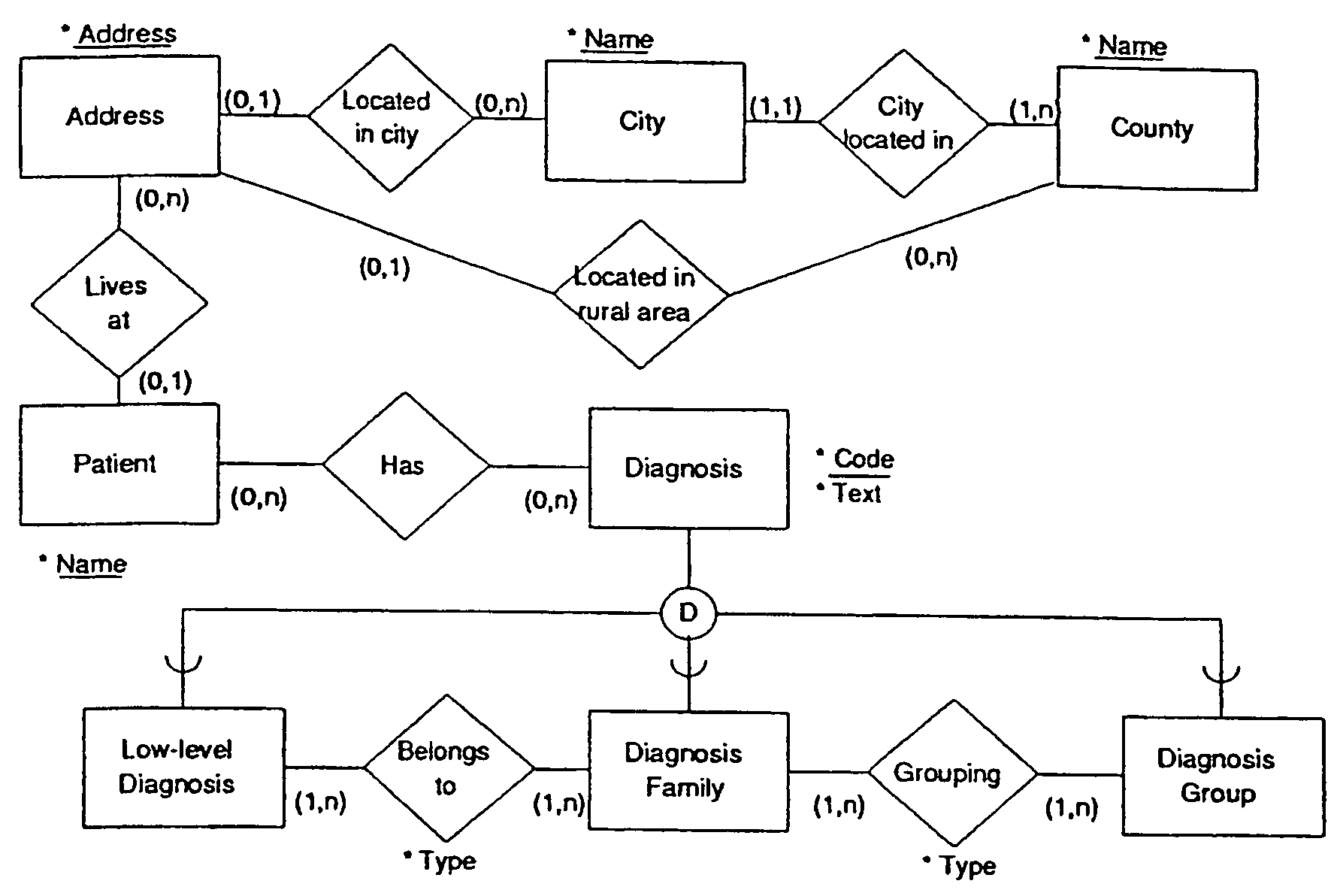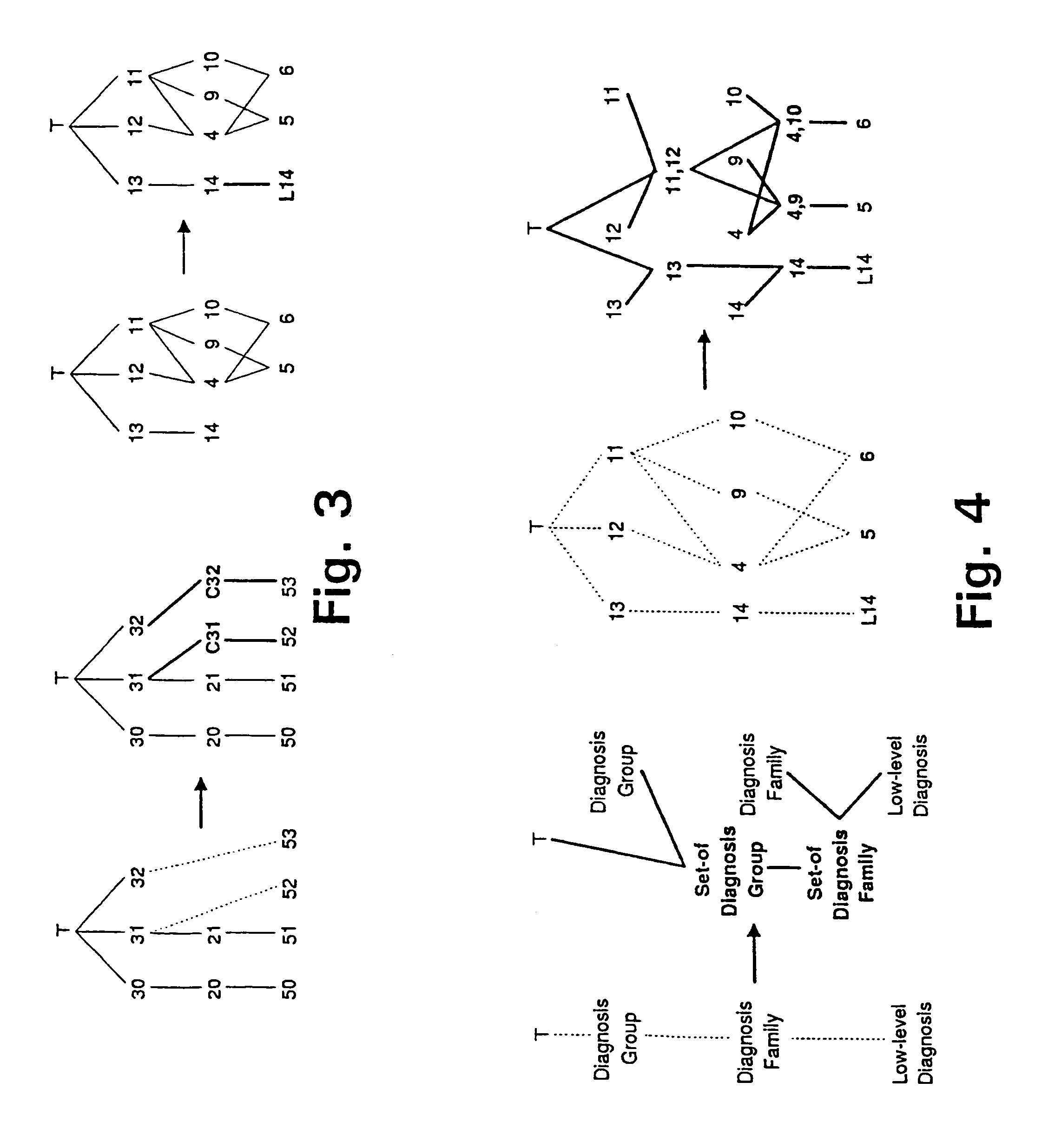Method and systems for making OLAP hierarchies summarisable
a hierarchical and olap technology, applied in multi-dimensional databases, instruments, data processing applications, etc., can solve the problems of increasing application size, increasing storage space, and increasing the amount of storage space required
- Summary
- Abstract
- Description
- Claims
- Application Information
AI Technical Summary
Benefits of technology
Problems solved by technology
Method used
Image
Examples
example 1
[0112]In the case study, Patient is the fact type, and Diagnosis, Residence, and Name are the dimension types. The intuition is that everything that characterises the fact type is considered to be dimensional.
[0113]A dimension type T is a four-tuple (C, ≦T, ≦TT, ⊥T), where C={Cj, j=1, . . . , k} are the category types of T, ≦T is a partial order on the Cj's, with TTε C and ⊥Tε C being the top and bottom element of the ordering, respectively. Thus, the category types form a lattice. The intuition is that one category type is “greater than” another category type if members of the formers extension logically contain members of the latter's extension, i.e., they have a larger value size. The top element of the ordering corresponds to the largest possible value size, that is, there is only one value in it's extension, logically containing all other values.
[0114]We say that Cj is a category type of T, written CjεT, if Cj εC.
example 2
[0115]Low-level diagnoses are contained in diagnosis families, which are contained in diagnosis groups. Thus, the Diagnosis dimension type has the following order on its category types: ⊥Diagnosis=Low-level DiagnosisDiagnosis. Other examples of category types are Address, City, and County. FIG. 2, to be discussed in detail later, illustrates the dimension types of the case study.
[0116]A category Cj of type Cj is a set of dimension values e. A dimension D of type T=({Cj}, ≦T, TT, ⊥T) is a two-tuple D=(C, ≦), where C={Cj} is a set of categories Cj such that Type(Cj)=Cj and ≦ is a partial order on ∪jCj, the union of all dimension values in the individual categories. We assume a function Pred: C 2C that gives the set of direct predecessors of a category Cj. Similarly, we a assume a function Desc: C 2C that gives the set of direct descendants of a category Cj. For both Pred and Desc, we “count” from the category TT (of type TT), so that category TT has no predecessors and category ⊥T (of...
example 3
[0119]In our Diagnosis dimension we have the following categories, named by their type. The numbers in parentheses are the ID values from the Diagnosis table in Table 1. Low-level Diagnosis={“Insulin dependent diabetes during pregnancy” (5), “Non insulin dependent diabetes during pregnancy” (6)}, Diagnosis Family={“Diabetes during pregnancy” (4), “Insulin dependent diabetes” (9), “Non insulin dependent diabetes” (10), “Lung cancer” (14)}, Diagnosis Group={“Diabetes” (11), “Other pregnancy related diseases” (12), “Cancer” (13)}, and TDiagnosis={T}. We have that Pred(Low-level Diagnosis)={Diagnosis Family}. The partial order ≦ is obtained by combining WHO and user-defined hierarchies, as given by the Grouping table in Table 1. Additionally, the top value T is greater than, i.e., logically contains, all the other diagnosis values.
[0120]Let F be a set of facts, and D=(C={Cj}, ≦) a dimension. A fact-dimension relation between F and D is a set R {(f, e)}, where fεF and eε∪jCj. Thus R link...
PUM
 Login to View More
Login to View More Abstract
Description
Claims
Application Information
 Login to View More
Login to View More - R&D
- Intellectual Property
- Life Sciences
- Materials
- Tech Scout
- Unparalleled Data Quality
- Higher Quality Content
- 60% Fewer Hallucinations
Browse by: Latest US Patents, China's latest patents, Technical Efficacy Thesaurus, Application Domain, Technology Topic, Popular Technical Reports.
© 2025 PatSnap. All rights reserved.Legal|Privacy policy|Modern Slavery Act Transparency Statement|Sitemap|About US| Contact US: help@patsnap.com



